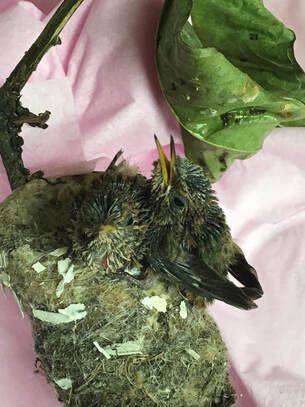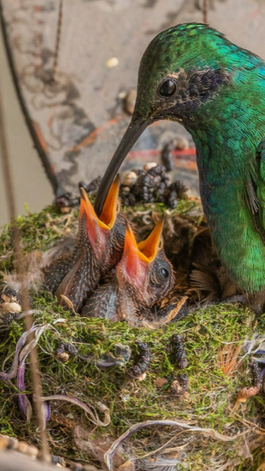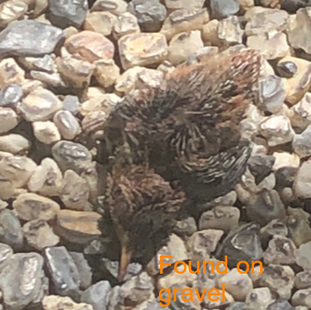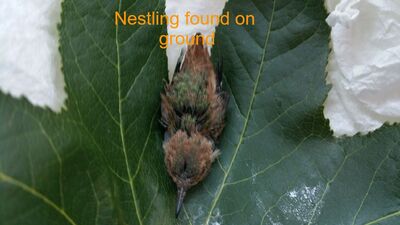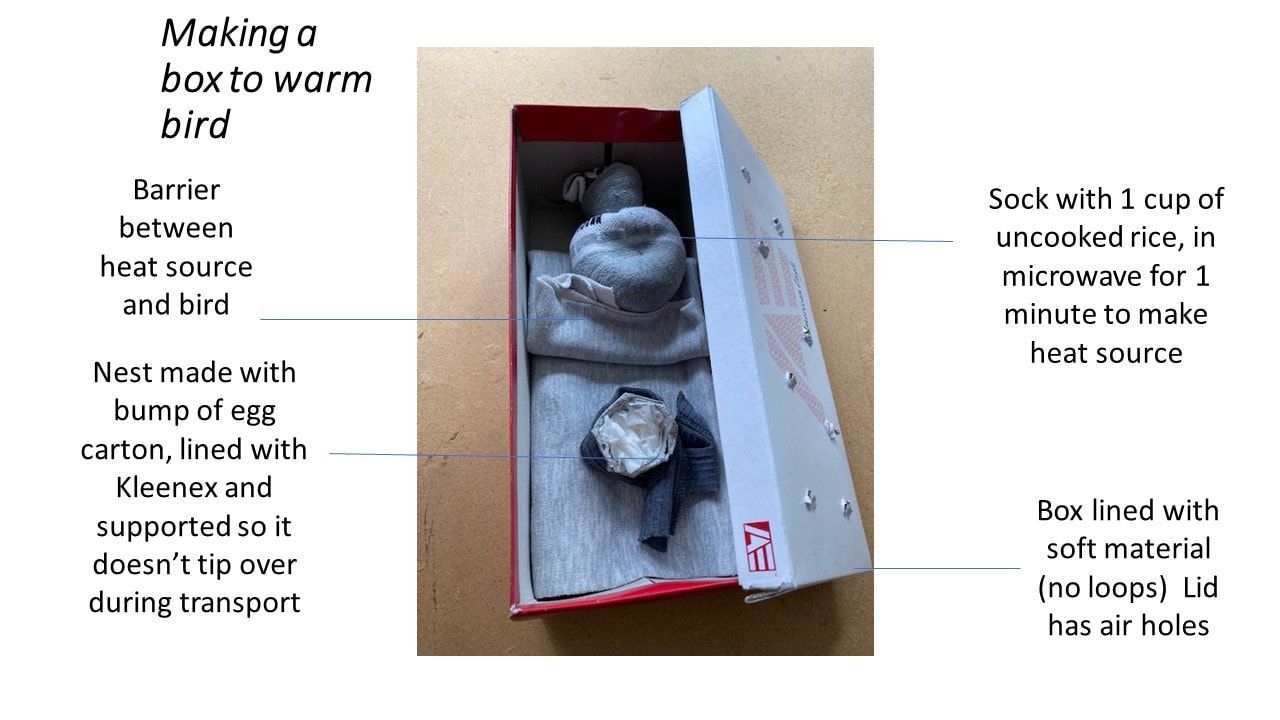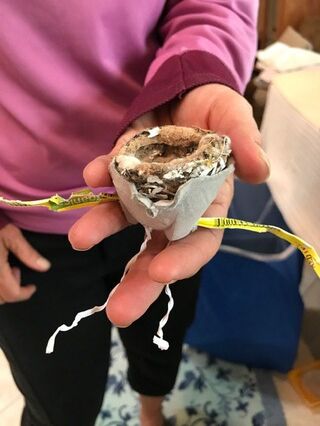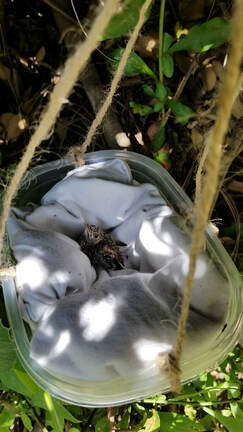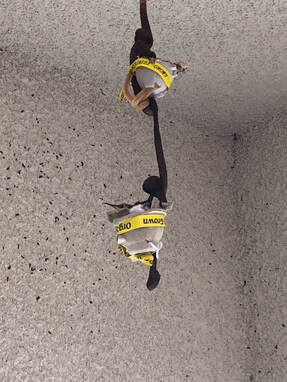NESTLINGS
7-21 days of age. They have pin feathers and their eyes are open. If you peak at their tummies, you will see skin.
|
At this age, mother does not sit on them. They are feathered enough to keep themselves warm. This confuses many observers because the mother is sitting on them one day, then the next, she is absent.
If this happens, watch for an hour at a respectful distance, without looking away. No phone breaks, no coffee breaks, just staring at the nest. She returns and feeds quickly, it takes less than 10 seconds to feed 2 babies, so if you look away, you will miss her. Once you see that she has returned, please leave them alone. Mothers have been known to abandon a nest when people keep looking at it and taking pictures. These are wild birds and their privacy should be respected. |
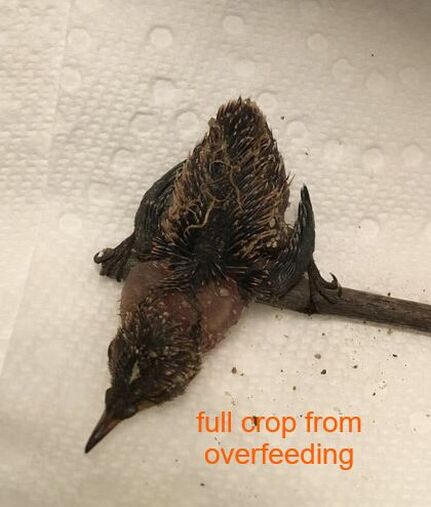
If you find one on the ground and it is warm to the touch and moving, look for the nest and return it. It must also be bug-free and the nest must be in good shape and reachable. Watch at a distance for the return of the mother. Watch without looking away. No cell phones, no bathroom breaks, just constant staring. If she has not returned in 30-45 minutes, call a rehabber. What could have happened to her? She may have been caught by a cat, or hit a window, or gotten hit by a car, gotten scared off by humans who keep taking pictures of the nest, or is caught in a garage. They do not willingly abandon their nests.
If the nestling is on the ground and cold, he must be warmed prior to returning to the nest. This can be done by holding him in your warm hands for 10 minutes. If he gets active and gapes (opens his mouth to be fed), return him to the nest and observe for the mother to return. If the mother has not returned in 30-45 minutes, call a rehabber. If he does not become active and gaping, call a rehabber. Until one can be reached, the baby needs to be warmed and kept warm. So this is what you do.....
Find an athletic sock and put in 1 cup of uncooked rice. Put the rice sock in the microwave for 1 minute. Cover the warm rice sock with a towel and place it in a shoebox lined with a towel or tee shirt. Use a salsa cup, or a bump from an egg carton, put tissue in it and put the baby in the cup. Put the cup in the shoebox with the warm rice sock (close but not too close) and cover the box with a lid with holes. DO NOT FEED THE BABY YET! Baby must be toasty warm before feeding is attempted, which will be at least 30 minutes, if not longer.
Once baby is warm and active, it's ok to feed just a little. Mix 1/4 tsp plain white sugar in 1 tsp warm (not hot) tap water. Dip a q-tip in the sugar water and put to baby's mouth (see video), give just a little. If you have an eye dropper, you can give 1 small drop into the open mouth. If you miss, or some gets on the baby, take a damp q-tip and clean him up. Don't let him be cold and sticky.
Feed baby every 30 minutes. Watch the side of his neck, if its bulging (see picture), then quit feeding until the bulge goes down. Keep sock warm and don't let baby get cold. (Picture shows a crop that is too full). This baby needs to be in a make-shift nest, warmed and no more food! And a rehabber.
He needs more than sugar water. Mom gives him a special blend of flower nectar, small flying bugs and sugar water. So this is only temporary until you can get him to a rehabber. Please do not feed him anything else. They do not eat seeds, egg yolk, breast milk (I'm not kidding, people do this), cat food, or meal worms. Feeding him the incorrect diet often leads to death. Don't do it... please.
ALWAYS OPEN THE BOX IN A BATHROOM. IN CASE THEY FLY A LITTLE.
If the nestling is on the ground and cold, he must be warmed prior to returning to the nest. This can be done by holding him in your warm hands for 10 minutes. If he gets active and gapes (opens his mouth to be fed), return him to the nest and observe for the mother to return. If the mother has not returned in 30-45 minutes, call a rehabber. If he does not become active and gaping, call a rehabber. Until one can be reached, the baby needs to be warmed and kept warm. So this is what you do.....
Find an athletic sock and put in 1 cup of uncooked rice. Put the rice sock in the microwave for 1 minute. Cover the warm rice sock with a towel and place it in a shoebox lined with a towel or tee shirt. Use a salsa cup, or a bump from an egg carton, put tissue in it and put the baby in the cup. Put the cup in the shoebox with the warm rice sock (close but not too close) and cover the box with a lid with holes. DO NOT FEED THE BABY YET! Baby must be toasty warm before feeding is attempted, which will be at least 30 minutes, if not longer.
Once baby is warm and active, it's ok to feed just a little. Mix 1/4 tsp plain white sugar in 1 tsp warm (not hot) tap water. Dip a q-tip in the sugar water and put to baby's mouth (see video), give just a little. If you have an eye dropper, you can give 1 small drop into the open mouth. If you miss, or some gets on the baby, take a damp q-tip and clean him up. Don't let him be cold and sticky.
Feed baby every 30 minutes. Watch the side of his neck, if its bulging (see picture), then quit feeding until the bulge goes down. Keep sock warm and don't let baby get cold. (Picture shows a crop that is too full). This baby needs to be in a make-shift nest, warmed and no more food! And a rehabber.
He needs more than sugar water. Mom gives him a special blend of flower nectar, small flying bugs and sugar water. So this is only temporary until you can get him to a rehabber. Please do not feed him anything else. They do not eat seeds, egg yolk, breast milk (I'm not kidding, people do this), cat food, or meal worms. Feeding him the incorrect diet often leads to death. Don't do it... please.
ALWAYS OPEN THE BOX IN A BATHROOM. IN CASE THEY FLY A LITTLE.
What if there's no nest??? And mom is present...
Let's build a new nest. Make sure baby is warm and alert. Feed a little sugar water if he is gaping (mouth open). You can use a bump from an egg carton or a small salsa cup. Line it with the old nest if you have it, or crunched up leaf litter. Put twisty ties (or pipe cleaners, or ribbon) through the bottom and put nest back where came from (or as close as you can get). Make sure it is level and deep enough for baby to sit it. You can also reinforce a damaged nest the same way. Be sure there are drainage holes in case it rains. NEVER USE TAPE on a nest. Just a little tape sticky can pull out feathers on baby and mom.
Place baby into new nest and watch for mom (at a respectful distance). Baby must be vocalizing, so set a timer for 30 minutes, but don't start it until he starts calling for her. Stare at the nest, no looking away or you might miss her. If mom doesn't return after 30 minutes of baby crying, then call a rehabber. Give her another 30 minutes, then feed baby a few drops of sugar water. If baby seems cold, remove the new nest and set it up in the above mentioned shoebox set up. And call a rehabber.
If the baby has bugs, it needs to be rescued. If it has been in a cat's mouth, it needs to be rescued. Cats have bacteria in their mouths (and on their claws, since they lick their paws), that are deadly to birds. The bird may look ok at first, but without antibiotics they become septic and usually die in 2 days. If it is injured, cold, lethargic and not opening his mouth to be fed, he needs to be rescued.
Place baby into new nest and watch for mom (at a respectful distance). Baby must be vocalizing, so set a timer for 30 minutes, but don't start it until he starts calling for her. Stare at the nest, no looking away or you might miss her. If mom doesn't return after 30 minutes of baby crying, then call a rehabber. Give her another 30 minutes, then feed baby a few drops of sugar water. If baby seems cold, remove the new nest and set it up in the above mentioned shoebox set up. And call a rehabber.
If the baby has bugs, it needs to be rescued. If it has been in a cat's mouth, it needs to be rescued. Cats have bacteria in their mouths (and on their claws, since they lick their paws), that are deadly to birds. The bird may look ok at first, but without antibiotics they become septic and usually die in 2 days. If it is injured, cold, lethargic and not opening his mouth to be fed, he needs to be rescued.
Proudly powered by Weebly
